The Power of Cross-Marketing: Teddy Boy Blues
Imagine making a game based on a song. A song of a futile love, heartbreak, and a teddy boy. Now, remember that it’s 1985, and you’re making an arcade game. (For the Sega System 1, as this is just the Sega System 1 blog now) Would you come up with a boy with a tiny grease gun that can shrink your foes rather than pump them full of lead running through a series of non-Euclidean mazes? …you wouldn’t? Well, thankfully, Ishii Youji did.
Teddy Boy Blues, the song
Teddy Boy Blues was the debut single of Japanese idol signer Yohko Ishino. It seems that Ms. Ishino would go on to have more success as an actress than a singer, but it is a very catchy song nevertheless. If you don’t happen to have the ability to import CDs from Japan, I did find this YouTube rendering, but no promises how long the copyright gods will allow it to exist. It’s also the first song on her Golden Best collection.

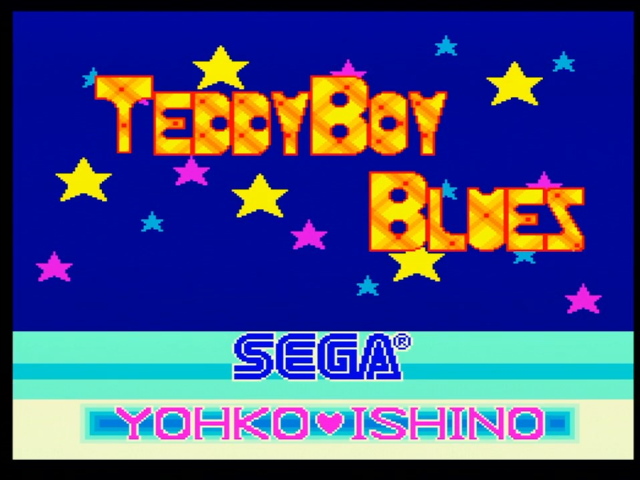
Teddy Boy Blues was not the first licensed video game; the usual credit for that goes to Sega’s 1976 Fonz. (At the time, Happy Days rights-owner Paramount shared a parent company with Sega) But it does seem to be a first for cross-marketing an idol singer and a video game. So that’s pretty innovative for the time; especially considering that at the time many games, even Sega’s 1984 Future Spy, didn’t even have soundtracks.
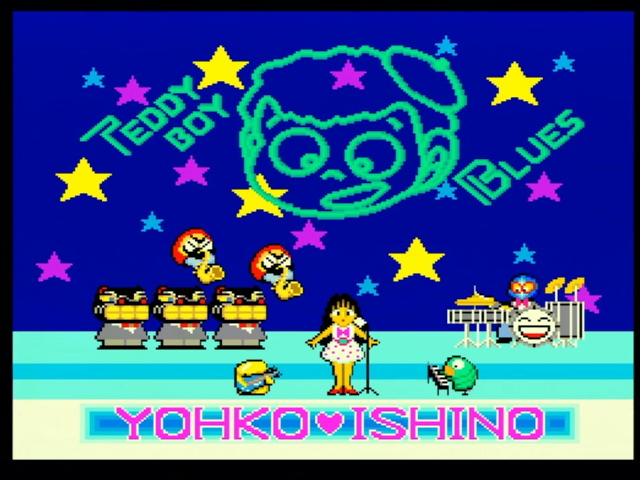
But let’s get it straightforward: Teddy Boy Blues the song doesn’t have too much to do with Teddy Boy Blues, the arcade game. Sure, you can see Ms. Ishino hosting a concert with some of the game’s enemies as backup singers on the attract mode. She’s also playable in the bonus game, and the game’s sole background music is a quite-good SN74689 rendition of the song. But the gameplay? Even if you don’t speak Japanese, you can probably guess that the song doesn’t have much to do with it.
Flicky
Ishii Youji has had a long career in the game industry as a producer and project manager stretching, as far as credits go, well in to the 2010s. Still, he seems to have gotten his start as a game designer right here on the System 1. Let’s look at what he was working on right before Teddy Boy Blues: an undisputed Sega classic, Flicky.

Flicky is the tale of a mother bird, sadly unable to fly, who must rescue all of her children from the grasps of hungry cats, and bring them to the “Flicky” platform at the stage’s exit. The cats, while hungry, do realize that a healthy ecosystem depends on allowing some of the animals to mature– therefore, they only target you. Your chicks fear them, though, and as they run behind you, if their path intercepts a cat they will run off. And of course, if you touch a cat, your game is over.

The Flicky port to the SG-1000 is quite impressive, because it keeps one of the game’s signature features. The world is continuous in the horizontal axis; go left, and you’ll eventually loop around. However, unlike Pac-Man, the screen scrolls along with your mother bird. She is always centered horizontally. This sort of scrolling is very difficult to pull off smoothly on the SG-1000; Flicky does it well.
The game is quite chaotic; you can bring your chicks to the nest one at a time, but there are huge score bonuses for bringing them all up. With a huge line of chicks behind you, cats are sure to disrupt it. This chaos in a looping world is the core gameplay loop of Flicky.
One Year Later…
So what did Ishii Youji have in store for his next title? First off, the scrolling has doubled. Now, you can move up and down. The stages complexity increases to match. Any connection to reality is lost (you could imagine Flicky as being in a tube-shaped building), but this encourages even more chaotic gameplay as enemies cross from one corner of the screen to the others. Enemies leap from dice that also count how many remain.

The other difference is that Teddy Boy (who, oddly, does not actually seem to be a teddy boy in the fashion sense) comes heavily armed, with a submachine gun. Teddy Boy, after all, did not come to pick up chicks. He came to destroy, and he won’t be done with a level until all life in it is gone.
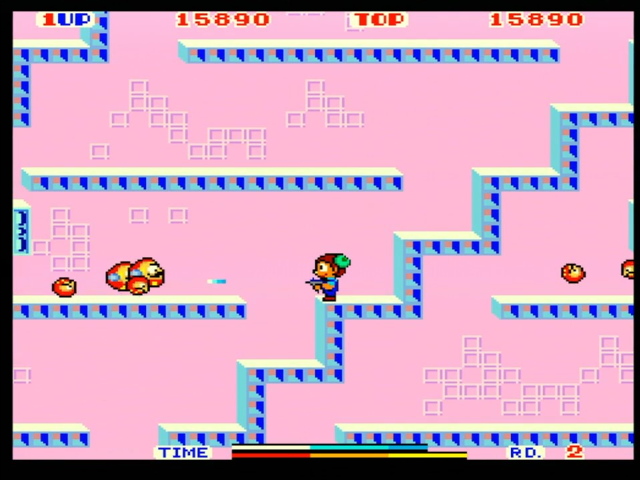
However, his gun isn’t enough for these enemies. Rather than kill them, they turn into smaller forms of themselves. These must be collected; they do not chain behind you and simply disappear if you do manage to catch them quickly. If you don’t, they’ll go and eat the timer at the bottom of the screen. It’s a silly mechanic but it helps keep you moving.
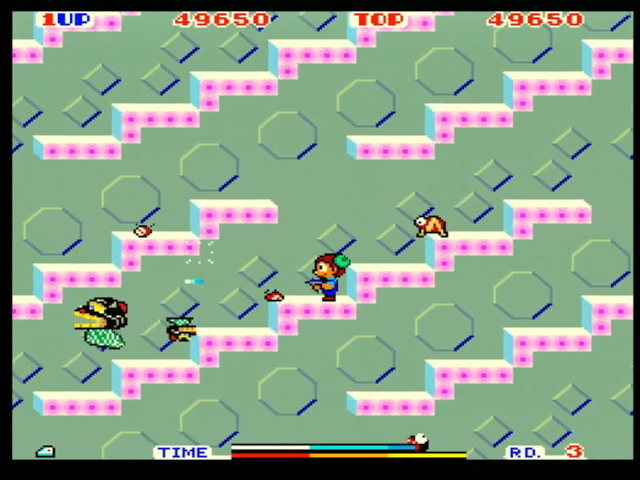
Teddy Boy Blues is in fact more chaotic than Flicky; the small maps and the constant screen scrolling mean that the closest path to an enemy is rarely a straight line. The levels get more complicated and enemy patterns are just random enough to keep them from being predictable. If you stand in the same place for too long, fire comes out to destroy the platform you’re standing on.

The chaos between levels is broken up by bonus stages, of which there are two types: either Teddy Boy shooting up a stage, or playing as Yohko herself as she searches her apartment for bags of money. (Being an idol is very lucrative, it seems) Does this make Yohko Ishino the first playable woman in a video game who is a real person? (Update: I realized on Twitter that Okamoto Ayako in 1984’s Okamoto Ayako no Match Play Golf is playable in multi-player, so the answer to my question is no.)

Hm. I don’t think her apartment is supposed to look like that.
Welcome to the real world

This is Teddy Boy Blues. Well, not quite. Teddy Boy Blues is a Japan-exclusive arcade game, and seems rather rare. This, on the other hand, was imported from Italy, and judging by the lack of any Sega-specific chips, is a bootleg. Yet again, we are involved in a crime. (I’m not sure why a Teddy Boy Blues bootleg was made, or why it ended up in Italy. Life is full of mysteries)
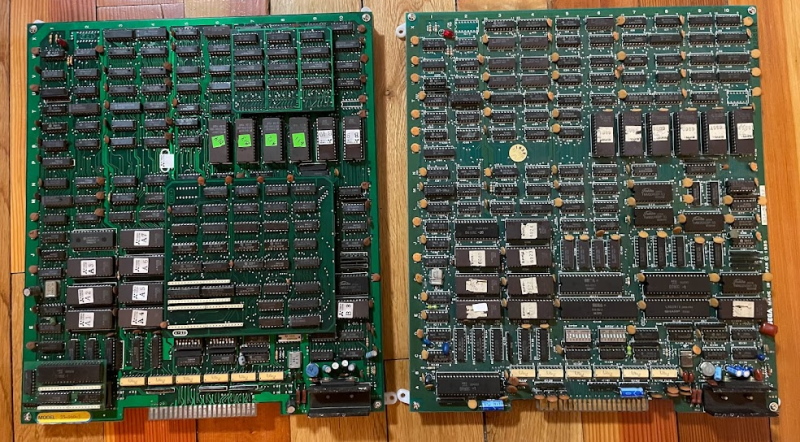
Looking side-by-side with a real System 1 board (My Hero in this case, but these were interchangeable) you can really see how it follows the Sega layout, with the large daughterboards containing discrete logic replacing the Sega chips. The second daughterboard farthest from the edge connector replaces a series of custom “315-5025” Sega ICs.
Living on the Edge
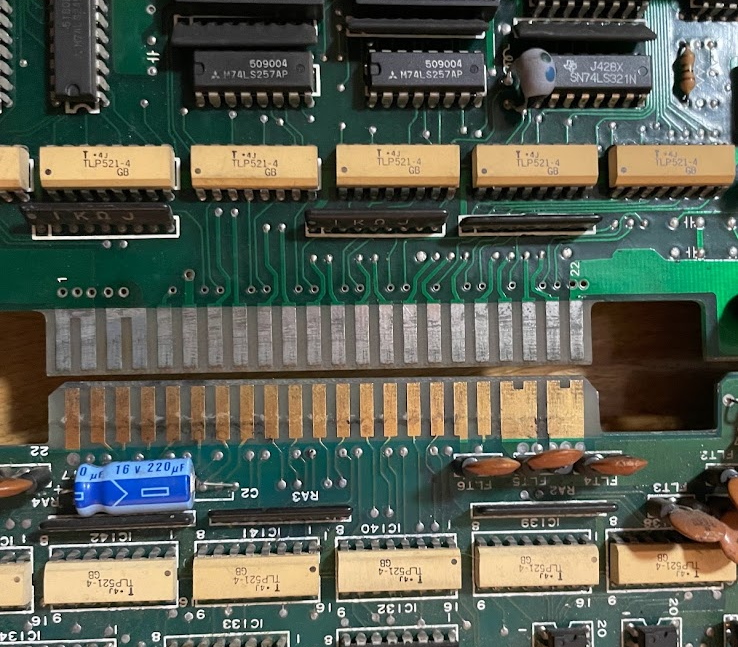
The first issue was from that edge connector. Compare it to the real Sega part and you’ll immediately see a difference; no gold plating on these traces. This makes it much easier for them to get dirty and make a bad connection, which was very evident: it caused the loss of sync, which is always exciting.
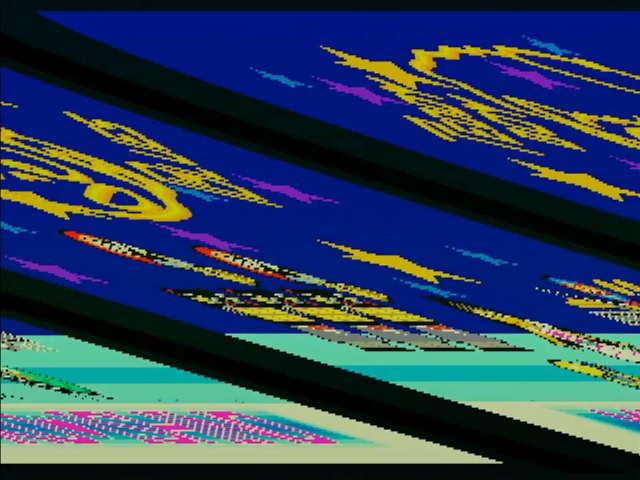
Thankfully, all that was required was some cleaning.
Shot connections
Those daughterboards are held in by sockets, and seem to have been partially dislodged in shipping. The lower one in particular (the one that replaced the Sega 315-5025 ICs) was finicky (likely as it’s only being held in by sockets on one side), and produced some fun errors when bad connections were made.
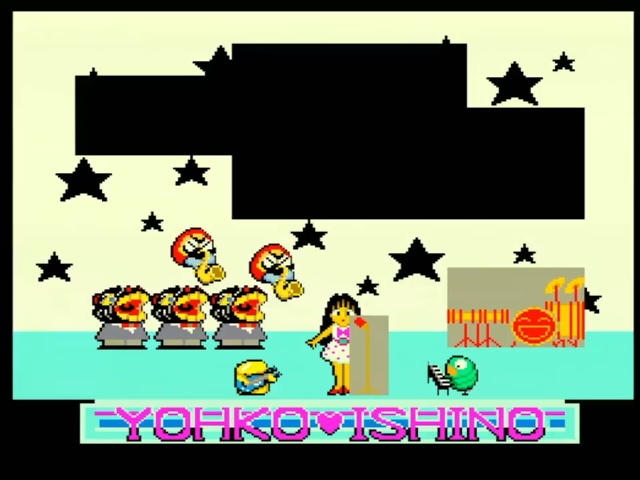
I’m guessing from the graphics this is playing some kind of role in decoding tiles; it’s interesting how transparent color becomes solid. A quick reseating resolved this.
This is why you buy legit
At this point, pretty much everything but the bonus games was working. Well, I say they were working; there were definitely intermittent pixel issues with the tiles still, but when they weren’t happening things looked fine. When they were…

So now the game code seems to be behaving correctly, and after reseating the daughterboards, so was the game hardware. What remained?
Arcade games like the Sega System 1 work very similar to the Nintendo Famicom. (Or, we should say, that the Nintendo Famicom works like an arcade game) Graphic tiles for the tilemaps and sprites are stored in ROMs that are accessed by the hardware directly, rather than anything being copied into video RAM like on the SG-1000.
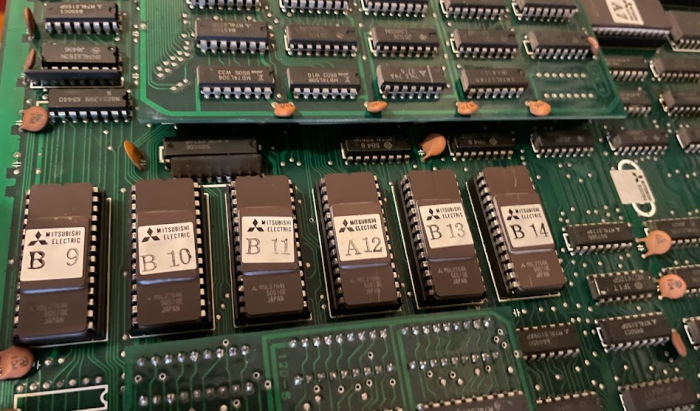
On this particular Teddy Boy Blues board, the graphics are stored in these Mitsubishi M5L2764K EPROMs. B9 and B10 read out alright, but looking at the last four, none would read. And the issue was quite obvious; most present on B13 (pictured below), but was visible across the board, even on the “good ones” of B9 and B10.
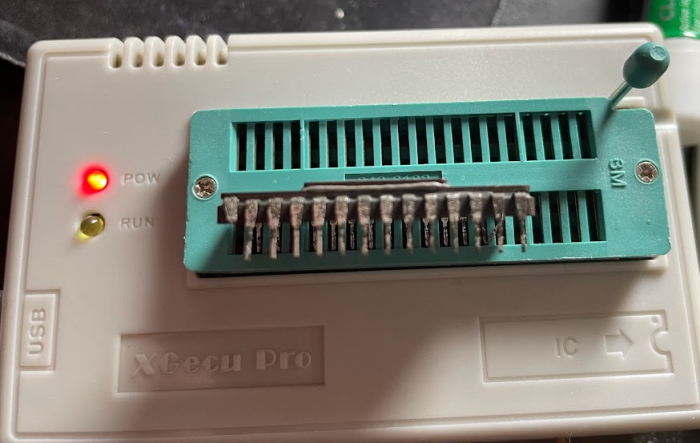
That’s corrosion, baby. Quite serious; that leg that came off literally did so at a touch. For those that did not fall apart, I gave things a good cleaning with a dull file to scrape away the corrosion, and deoxit’ed the sockets thoroughly. Cases like this seem to usually be because of poor-quality sockets causing differing-metal corrosion, but I didn’t replace the sockets as I didn’t want to risk damaging the board.
Of course, B13 lost two pins, and so really shouldn’t be going back in. And so I ordered some more Mitsubishi M5L2764K EROMs, only to find that my TL866-style EPROM programmer couldn’t program them; they seem to require 21V as a programming voltage, which is more than the little thing handles. I replaced them with AMD-made 2764’s, and so far (fingers crossed) they have thankfully worked without a hitch.

I eventually found that despite my cleaning, I had to replace all four problematic EPROMs before Yohko’s apartment actually was fully visible. I’m not exactly sure how the System 1 lays out its ROMs, but it’s definitely not uncommon for arcade boards to spread the pixels of a tile across multiple chips; this makes it easier to access things in parallel. Since I only had four 2764’s, I was quite glad to have the two fully working EPROMs.
Okay! We now have a working Teddy Boy Blues.
Bonus games

As you can see, Yohko Ishiko was using the same logo that appears on her Golden Best album back in 1985, as it appears on the bonus game select screen. The bonus games, despite all the effort to get them to work, are just simple affairs for some bonus points, with no real consequences for doing poorly.
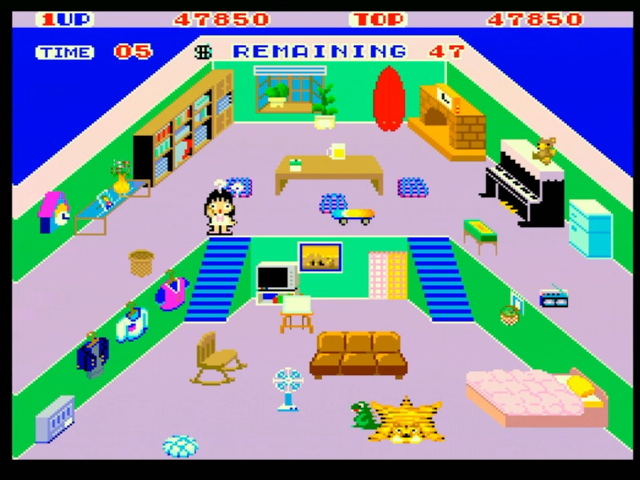
Still, it’s always nice to have a break in the action. Honestly, while I find the Yohko game more amusing, I have to admit the Teddy Boy bonus game is much easier to rack up points in. It’s a sort of shooting gallery with a behind-the-shoulder perspective.
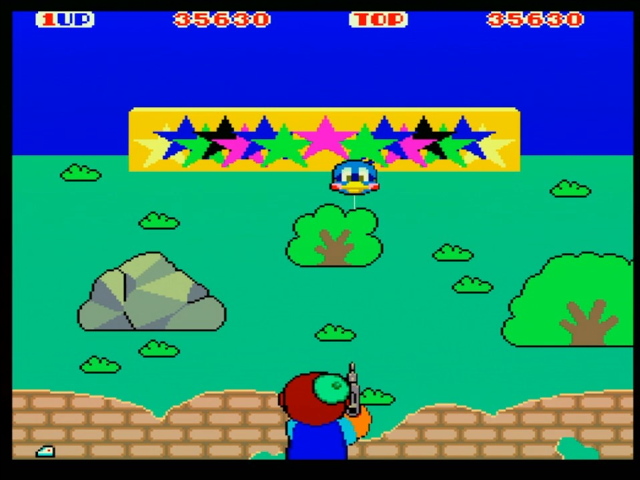
The Blues Go On
Teddy Boy Blues didn’t end with the arcade release. I hoped to cover some of the game’s adaptation process here, but the repair ended up being a bit more complicated to cover, so I’m going to move that to a follow-up post. (So many multi-part posts! They never seem to do well, but I keep doing them.) At least the repair was successful; this is the most complex one I’ve done myself on an arcade board.

I leave on this note: is Teddy Boy’s ghost deliberately taking advantage of the odd half-pixel effect on the right-most pixel of sprites on the System 1, or is that just a coincidence that it makes it look more transparent? I can’t tell.
A series on: The Teddy Boy Blues
It's a song, it's a game, it's a lifestyle! Well maybe not that last one.
- The Power of Cross-Marketing: Teddy Boy Blues — Teddy Boy Blues the song and the 1985 Sega System 1 arcade release.
- The Teddy Boy Blues Just Don't Stop — Yohko Ishino is left behind as her song becomes a game that's ported to the Master System and the Sega Genesis (and even makes its way onto the Sega CD twice).
